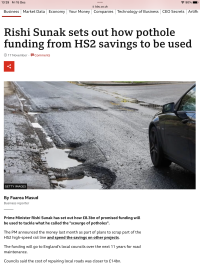As someone who used to work in the highway sector (albeit over a decade ago) I can confirm there are numerous facets to this and (as usual) it's not as simple as it seems (and for simplicity, I'll exclude all the human factors around vehicle use, increasing weight of vehicles, move away from public transport etc. and just stick to the engineering side of things):
1) The road network saw fairly substantial growth and generous investment in the 90s, meaning a lot of new surface was laid within a relatively short period of time
2) Labour's de-trunking scheme of the early 2000s transferred a huge number of roads into the local authority asset inventories; their budgets didn't really adjust accordingly (as anyone who has had a peek at local authority finance models, if you don't spend X in year 1, don't necessarily expect to get as much as X allocated again in year 2), but it wasn't a short term issue as the condition of the roads was reasonable
3) The materials used in road surface construction were of a better quality 30 years ago; they simply lasted better
What happened was a combination of these three factors meant that from the early 2010s lots of road surfaces were heading towards the end of their natural life simultaneously, but many local authorities had been enjoying a period of relatively low budget demands for highway maintenance. When faced with deteriorating assets without the massive budgets needed for full-scale resurfacing, they turned to mechanisms that would prolong the life of the network; things like patching and surface dressing. While perfectly acceptable when done correctly, ultimately it's just kicking the problem down the road (sorry for the pun) for what as is turns out is an increasingly austere public finance picture.
So fundamentally local authorities have a massive financial obstacle at a time when they're on their knees. Yes, this is partly due to short-sighted funding decisions but every government organisation, local or national, tends to only think as far as the next election.
Finally, the situation has been exacerbated by the massive increase in "third party claims" (i.e. claiming for a bent wheel after hitting a pothole, or falling off a bike and claiming personal injury). 20 years ago this was very rare, OK so yes there were less defects to "trip up on", but the whole culture has changed. Now the default is "where there's a blame, there's a claim" and a whole industry of people supporting this. The problem is, as soon as a highway authority is notified of a defect that might potentially be dangerous and/or contravenes their intervention levels, they then have to go and inspect it and "make it safe" and they are obliged to do this within a certain time period (usually depending on the severity). The action associated with the latter will be a quick fix as you can't resurface an entire road every time. The cost of these little fixes, the fact they're short notice and can't be programmed effectively means it is disruptive and expensive, draining an already scarce budget.
It's a bit of a perfect storm really with no easy way out unfortunately.

















